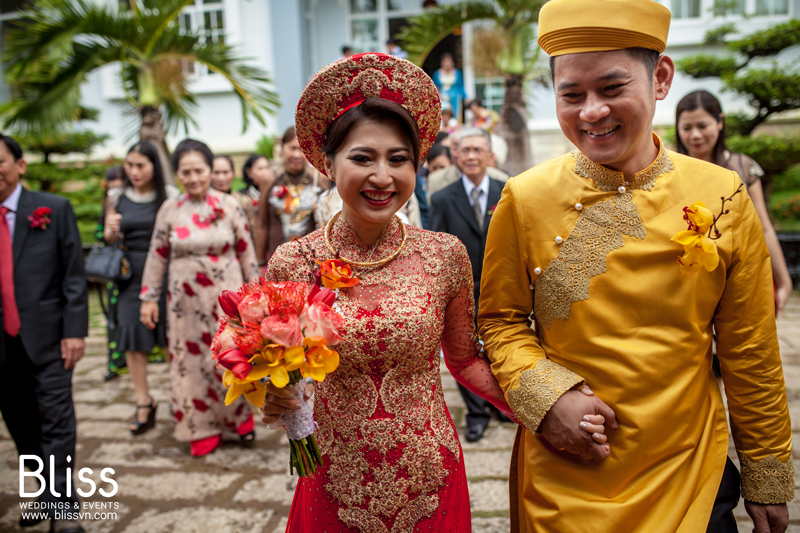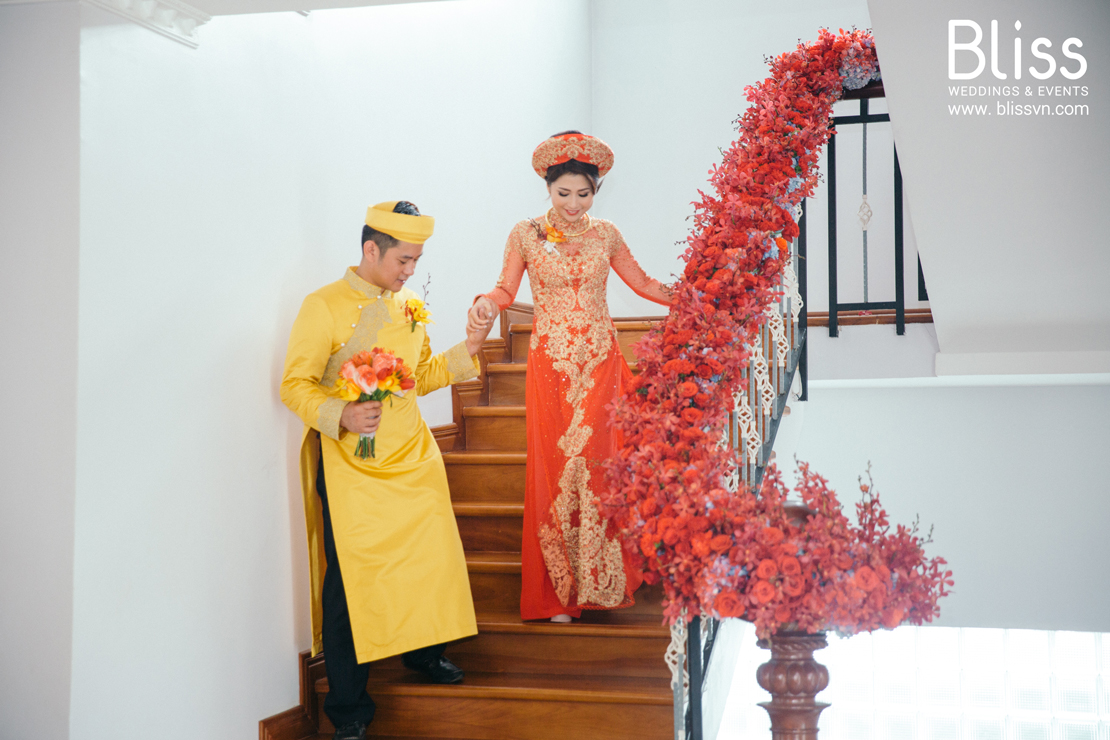
The traditional Vietnamese wedding is one of the most important ceremonies in Vietnamese culture with influence from Confucian and Buddhist ideologies. (Wedding Ceremony by Bliss Weddings & Events))
The Vietnamese usually combine the betrothal ceremony and the engagement party in one and it is often more important than any other aspect of the marriage.
The reason why this can be viewed as being both an engagement party and a betrothal ceremony, is because an engagement party is a public announcement that the couple intends to marry, thereby making the focus on the couple's plans for their wedding. A betrothal ceremony is a public announcement that the couple is preparing to marry and that the focus is on each other. In some respects, it is the first opportunity to change the couple's focus from 'me' to 'we'."
The actual Vietnamese wedding ceremony, which is also followed by a church wedding and reception, includes the exchange of several symbolic gifts and a time to receive blessings from both families.
"When an individual gets married, they are not just marrying their future spouse, they will be marrying their spouse's families," Lee says.
When Are Weddings Held?
In Vietnam, most weddings (or an hois) coincide with fieldwork season, which means couples tend to have their weddings in winter or fall months. In North America, couples often consult a fortune teller to pick the most auspicious date for the couple.
The Colour Red
Before the wedding, the groom's family arranges gifts. The wedding day starts off with the presentation of these gifts. The gifts are placed on a number of round red trays and the number of trays should be an odd number. The larger the amounts of trays, the larger amount of wealth is displayed. The gifts are then covered by a red colour paper or cloth. Vietnamese believe that odd number and the red colour will bring luck to the couple.

Vietnamese believe that odd number and the red colour will bring luck to the couple. (Weddings Ceremony by Bliss Weddings & Events)
The Importance Of The Gifts
This portion of the wedding ceremony is crucial in terms of uniting families and the couple. Other gifts include areca nuts and betel leaves for example. Apparently the chewing of the areca nuts starts the dialogue between the two sets of parents. Therefore, it symbolizes the ideal married couple becoming inseparable. Other important and symbolic gifts include wine, tea, pastries, sticky rice, fruits and most importantly a whole roasted suckling pig.
.jpg)
Some days before the wedding, they will visit the bride and her family with round lacquered boxes known as betrothal presents. (Weddings Ceremony by Bliss Weddings & Events)
Family Representatives
During the wedding ceremony, both families choose a number of representatives (often young and unmarried). Males represent the groom bearing gifts and females represent the bride and receive the gifts.
Next the bride's representative presents the bride to the groom. The couple kneels and prays in front of the bride's family altar asking for permission and approval from the bride's ancestors.
After bowing to their parents as a sign of respect and then to each other, the groom gives his bride an engagement ring.
The Dam Hoi (Tea Ceremony)
After the gift and ring exchange, there is a traditional tea ceremony called the dam hoi. Here, the couple serves wine or tea to their older family members, while these family members congratulate the couple with monetary gifts or jewelry. Typically the groom's mother would put earrings or a necklace on her new daughter-in-law as a symbol of welcoming her into the groom's family.
After this ceremony, the bride will go back to the groom's house for another tea ceremony, usually followed by a western wedding (in a white dress) and a full out reception. The actual wedding day is extremely long for both the couple and their family members.
.jpg)
After the gift and ring exchange, there is a traditional tea ceremony called the dam hoi (Weddings Ceremony by Bliss Weddings & Events)
But What About These Gifts?
Back to the gifts. If the engagement party isn't held on the same day, both families will feast on food the bride's family arranges. When it comes to the gifts, there isn't a 50/50 divide. The smaller part is given back to the groom’s family indicating that the groom's family has been far too generous and the bride’s family also does not want to appear as being greedy.
What Does The Couple Wear?
The bride usually wears a red or pink long dress called an ao dai which includes a cloak embroidered with imperial symbols like a phoenix. She may also wear a hat called a khan dong while the groom's outfit is blue.

By accepting the toast, the bride's family agrees for the groom’s family to enter their house. (Weddings Ceremony by Bliss Weddings & Events)
Superstitions Are Everywhere
Vietnamese culture is very superstitious. Lee says it is considered unlucky for women to get married at the age of 22, 23, 26 or 28. Women are also considered "past due" by the age of 30 and for men, it's 35.
Other superstitions include the couple not seeing each other before the wedding day and the bride's mother combing the bride's hair with symbolic combs for luck and happiness.
Let's Eat
Make sure you come with an empty belly. Lee says traditionally the dinner feast is Chinese food and six to 10 courses — with at least half the courses in seafood. You may even find a bottle of Remy Martin cognac at each table. It is for the guests to open and consume.
The Meet And Greet
During the reception, there is also a meet and greet. During this time, the couple may change back to their traditional clothes and go to each table to greet guests. Toasts will also be made to the couple.
.jpg)
People still maintain Vietnamese traditional ceremony in the bride's home before heading to temples or churches. (Weddings Ceremony by Bliss Weddings & Events)
The Guest
While the ceremonies are quite small themselves (don't be surprised if you're not invited), the receptions can get quite large. While traditionally, it was the bride's family that had to pay for the engagement party and the wedding ceremony, while the reception was covered by the groom's family, these days the couples can do a split or find a middle ground.
If you're not sure what to bring as a gift, stick to money.
If you're not sure what to bring as a gift, stick to money. (Weddings Ceremony by Bliss Weddings & Events)